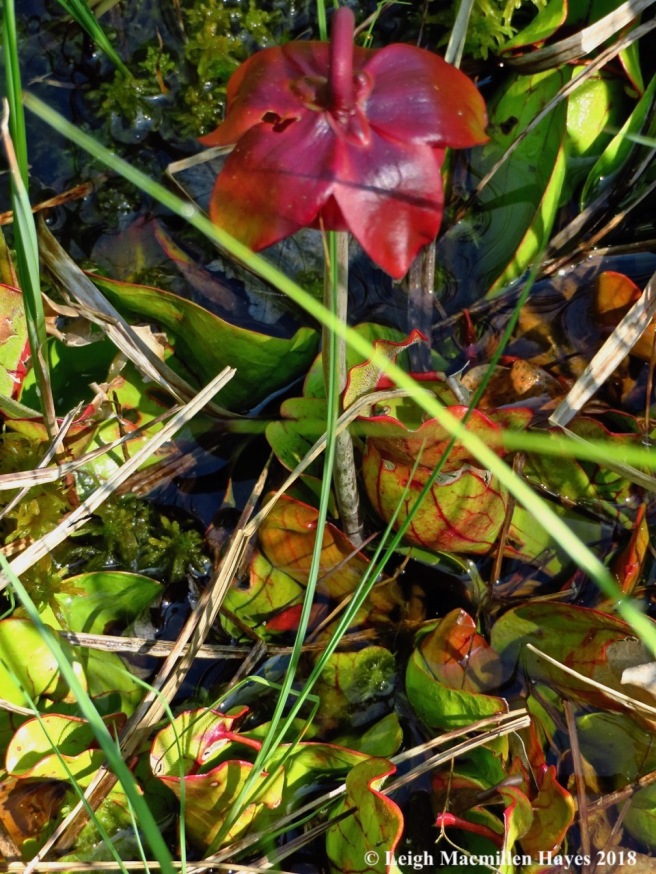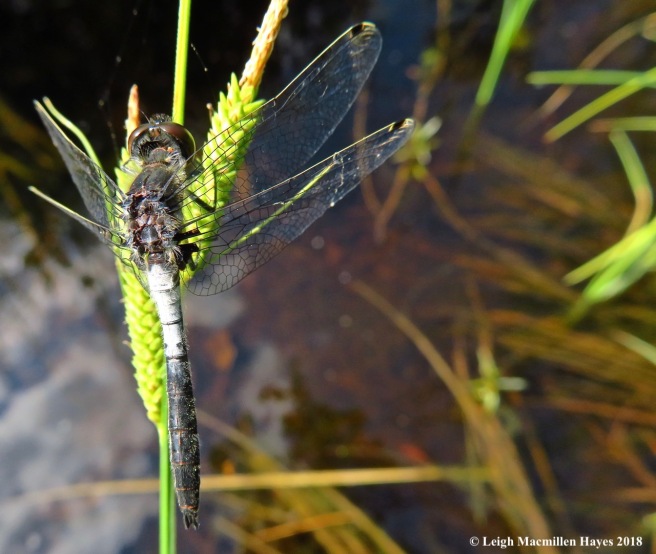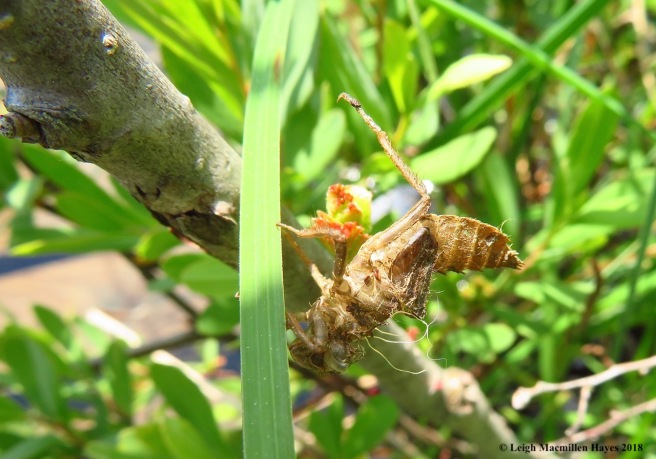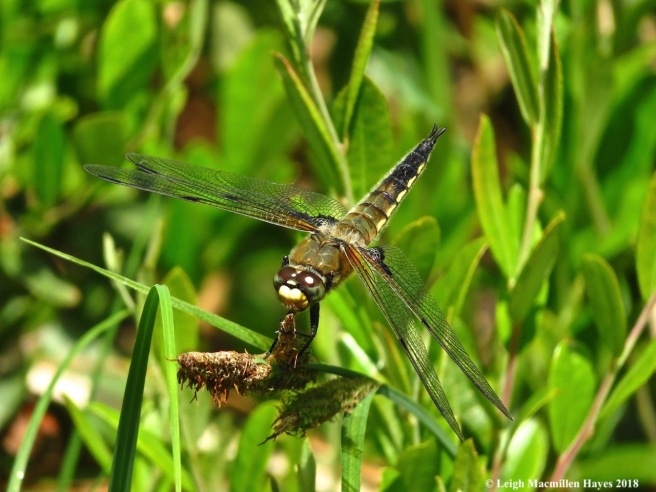One doesn’t necessarily step into the woods and expect transcendent events to occur, but then again by learning to live in the moment one never knows what to expect. And so it was that I traveled the trail at LEA’s Holt Pond Preserve with my friend Ann this morning–both of us delighted to just spend some quiet time exploring together.

Our tramp began with a pause beside bunchberries because it’s a plant I always associate with Ann due to her trailside teaching about its finer points years ago. Today, as the flowers began to morph into fruit, it was the points of the four white petal-like bracts and green leaves that asked to be noticed in the most subtle of ways for each was decorated with a dewdrop.

Not far beyond where the bunchberries grew, we stepped onto the first of the boardwalks that provided for a delightful amble through the red maple swamp.

Just off the edge of the wooden walkway, we spied some eyes starring up at us and realized we were the subject of the green frog’s discontent.

His camouflage almost worked as he tried to hide among the sphagnum moss . . .

but again we found him. How did we know he was a he? By his tympanum (ear), the circle behind his eyes. We really wanted to see him feed and if you look closely, you may see a mosquito and other insects nearby, but he seemed focused on us–in case he needed to defend his territory we supposed.

A wee bit further we met the first of many of their kind–the incredibly unique pitcher plants with their strikingly beautiful magenta flowers that stood like the wind spinners we used to create as kids.

In the water below were the pitcher-shaped leaves that gave this plant its common name.

The carnivorous pitcher plant obtains nitrogen and phosphorus by eating insects. Its oddly shaped leaves form a pitcher partly filled with water and digestive enzymes. The spout is a hairy landing platform for insects attracted by its red venation and nectar glands. Imagine this: An insect crawls to the edge of the leaf, aka pitcher, slips on the downward-sloping hairs and plunges into the liquid below where enzymes and bacteria break it down. Any chances for escape are zapped by those stiff hairs.

As we paid attention to the plant, damselflies and dragonflies, like this Frosted Whiteface Skimmer, flew in the surrounding airspace. We appreciated that he landed so we could take a closer look at the details of his body, including the golden outline of the upper edge of his wings.

Moseying along, our next great find was a red maple leaf, which made perfect sense given that we were in the midst of the red maple swamp. What didn’t make sense was the fact that it donned its autumnal coloration, but ours was not to make sense of everything.

At last we reached the boardwalk to the Muddy River, where we embraced stillness and listened to the green frogs strum their banjo voices and red-winged blackbirds sing their conk-la-ree songs.

One blackbird, in particular, stood out as if he were the king of the river. We didn’t realize it at the time, but the photographs tell the story for he did have a subject in mind–in the form of a painted turtle.

Off his high horse he flew, but continued to squawk from a lower pulpit. What did it all mean?

While we’ll never know, he did seem pleased with a gaze into his own reflection.

Our gaze also became more focused when we realized we stood in the midst of a newly emerged dragonfly. By its cloudy wings folded over its back damselfly-style and the abandoned exuvia on the other side of its perch did we realize what we were witnessing.

We felt a sense of caretakers for suddenly it was our honorable duty to stand watch and protect this vulnerable being from becoming prey. With wonder, we watched as it slowly changed position and suddenly spread its wings. For at least an hour we stood sentry and noted the slightest changes while we delighted in how the breeze occasionally fluttered through its wings.

Oh, we looked around and spied a female Eastern Forktail damselfly . . .

and many a Chalk-fronted Corporal dragonfly among others.

But our attention continued to return to the subtle beauty before us. How did it know to climb the vegetation? How did it know to emerge? How did it know today was sunny? How could such delicate wings support its meaty body? Where do dragonflies hang out on rainy days? How long would it take before it flew off? Our questions were numerous, but . . .

in a flash, as I moved in for a closer shot of the exuvia, the dragonfly decided it had posed for enough photos, and Ann and I watched with continued fascination as it flew off. Really, we felt like proud parents who had sent our offspring into the world. And we rejoiced. We had just witnessed one of nature’s greatest spectacles. It wasn’t only thrilling to watch, but was an all-encompassing experience that pulled us in with our sight and minds.

After such an awe-inspiring opportunity, we couldn’t imagine anything else, but as we moved along the boardwalk through another section of the red maple swamp we again encountered pitcher plants.

And this time we decided to take a closer look at the flower structure, which was umbrella-like with those five broad and waxy sepals situated above. Unless you physically turn it and take a peek, it’s difficult to see what is going on beneath where five more bright red, oval petals, curved in at the base and covered the ovary.

Within, yellow stamens surrounded the base of ovary. Below, a slender style extended from the round ovary and flattened out into an angled yellowish green structure like an inverted umbrella that curved back over the center of the flower. Certainly another novel spectacle for us to behold.

Along the same stretch we were equally wowed by a Four-spotted Skimmer.

He gave us the opportunity to take in his mightiness from more than one vantage point.

At last we reached the quaking bog and despite the water that filled our hiking boots, we moved forward toward Holt Pond with some caution. (Think right wrist still in cast.)

Along the way we discovered an abandoned caddisfly larva case,

blue flag irises,

another green frog,

and a huge tadpole swimming over the boardwalk.

At the water’s edge, though we sought sundews and could find none where they used to grow in abundance, we did realize someone had come with a different quest and because it seemed the pickerel weed roots had been foraged, we suspected a muskrat.

After enjoying the view and trying to make the bog quake by jumping to no avail, we journeyed on.

Our walk back via the road passed much more quickly and in what seemed like no time, we were at the parking lot. But I had one more site to show Ann and so we headed down to the Muddy River, our circle completed–though we were a wee bit east of our first river encounter.

It’s there that LEA has long left a canoe for anyone to use–just bring you own paddles and pfds.

And as our walk had begun, so it ended . . . with us again looking at bunchberries. but these were different for they were covered with sawdust and we suspected carpenter ants were busy residents in the pine tree behind them.

Because we were looking we were again rewarded as we noticed something else–a dragonfly exuvia.

And behind the tree two ghosts stared up at us in awe–completing the picture of this morning filled with the otherworldly so often encountered in nature.

That is an excellent place in which to spend some time! The frog is very bright and pretty, and I loved seeing the pitcher plant. They are not native here and so I’ve never seen one. I can see how that canoe would be inviting too.
LikeLiked by 1 person
And the best part–few others go there. We had the place to ourselves today.
LikeLiked by 1 person
That’s a real plus. I very seldom see anyone else on the high trails here and that’s just the way I like it!
LikeLiked by 1 person
I loved taking the walk with you and Ann again, always something different to discover, just wonderful. Thank you for taking me along. Ursula
>
LikeLiked by 1 person
You are always with me whenever I journey there, Ursula. Hugs.
LikeLike
I love the red winged blackbird and the painted turtle. I would have thought maybe one or the other had a nest nearby? But the blackbird nests high up, right??
LikeLiked by 1 person
Typically the nest close to the ground–in cattails, sedges, willows and alders., so you are probably right.
LikeLike